ESP MAZDA MODEL 3 4-DOOR 2018 Owner's Guide
[x] Cancel search | Manufacturer: MAZDA, Model Year: 2018, Model line: MODEL 3 4-DOOR, Model: MAZDA MODEL 3 4-DOOR 2018Pages: 624, PDF Size: 59.23 MB
Page 493 of 624

Do not spray water in the engine
compartment. Otherwise, it could result
in engine-starting problems or damage
to electrical parts.
When washing and waxing the vehicle,
be careful not to apply excessive force to
any single area of the vehicle roof or the
antenna. Otherwise, you could dent the
vehicle or damage the antenna.
To help protect the finish from rust and
deterioration, wash your Mazda
thoroughly and frequently, at least once a
month, with lukewarm or cold water.
If the vehicle is washed improperly, the
paint surface could be scratched. Here are
some examples of how scratching could
occur.
Scratches occur on th e paint surface when:
The vehicle is washed without first
rinsing off dirt and other foreign matter.
The vehicle is washed with a rough, dry,
or dirty cloth.
The vehicle is washed at a car wash that
uses brushes that are dirty or too stiff.
Cleansers or wax containing abrasives
are used.
NOTE
Mazda is not responsible for scratches
caused by automatic car washes or
improper washing.
Scratches are more noticeable on
vehicles with darker paint finishes.
To minimize scratches on the vehicle's
paint finish:
Rinse off any dirt or other foreign matter
using lukewarm or cold water before
washing.
Use plenty of luke warm or cold water
and a soft cloth when washing the
vehicle. Do not use a nylon cloth.
Rub gently when washing or drying the
vehicle.
Take your vehicle only to a car wash
that keeps its brushes well maintained.
Do not use abrasive cleansers or wax
that contain abrasives.
CAUTION
Do not use steel wool, abrasive cleaners,
or strong detergents containing highly
alkaline or caustic agents on
chrome-plated or anodized aluminum
parts. This may damage the protective
coating; also, cleaners and detergents
may discolor or deteriorate the paint.
Pay special attention to removing salt, dirt,
mud, and other forei gn material from the
underside of the fenders, and make sure
the drain holes in the lower edges of the
doors and rocker panels are clean.
Insects, tar, tree sap, bird droppings,
industrial fallout, and similar deposits can
damage the finish if not removed
immediately. When prompt washing with
plain water is ineffective, use a mild soap
made for use on vehicles.
Maintenance and Care
Appearance Care
6-65
Mazda3_8GE4-EA-17F_Edition1 2017-4-7 11:59:21
Page 505 of 624
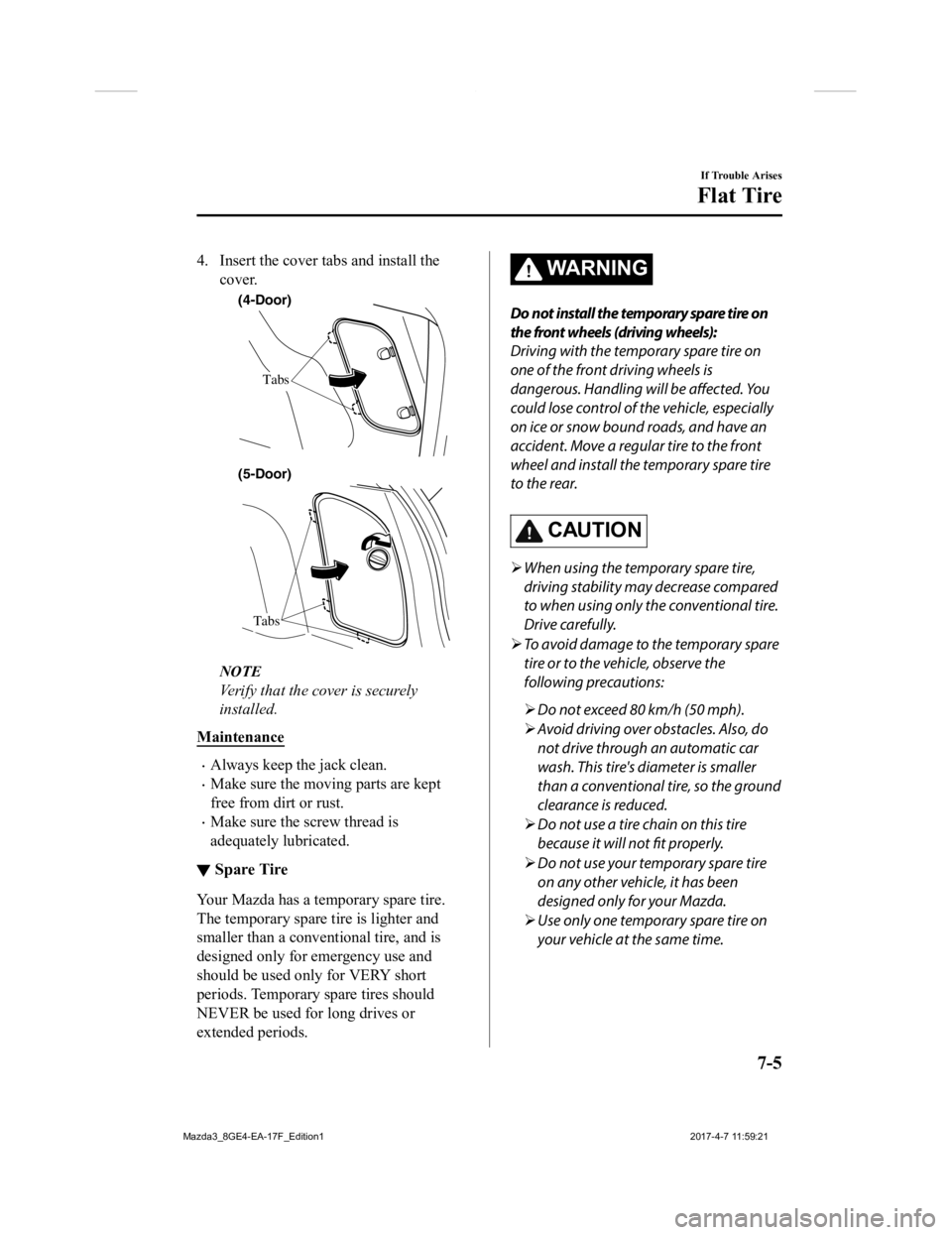
4. Insert the cover tabs and install thecover.
(4-Door)
Tabs
Tabs
(5-Door)
NOTE
Verify that the cover is securely
installed.
Maintenance
Always keep the jack clean.
Make sure the moving parts are kept
free from dirt or rust.
Make sure the screw thread is
adequately lubricated.
▼ Spare Tire
Your Mazda has a temporary spare tire.
The temporary spare tire is lighter and
smaller than a conventional tire, and is
designed only for emergency use and
should be used only for VERY short
periods. Temporary spare tires should
NEVER be used for long drives or
extended periods.
WA R N I N G
Do not install the temporary spare tire on
the front wheels (driving wheels):
Driving with the temporary spare tire on
one of the front driving wheels is
dangerous. Handling will be
affected. Yo u
could lose control of the vehicle, especially
on ice or snow bound roads, and have an
accident. Move a regular tire to the front
wheel and install the temporary spare tire
to the rear.
CAUTION
When using the temporary spare tire,
driving stability may decrease compared
to when using only the conventional tire.
Drive carefully.
To avoid damage to the temporary spare
tire or to the vehicle, observe the
following precautions:
Do not exceed 80 km/h (50 mph).
Avoid driving over obstacles. Also, do
not drive through an automatic car
wash. This tire's diameter is smaller
than a conventional tire, so the ground
clearance is reduced.
Do not use a tire chain on this tire
because it will not fit properly.
Do not use your temporary spare tire
on any other vehicle, it has been
designed only for your Mazda.
Use only one temporary spare tire on
your vehicle at the same time.
If Trouble Arises
Flat Tire
7-5
Mazda3_8GE4-EA-17F_Edition1 2017-4-7 11:59:21
Page 560 of 624
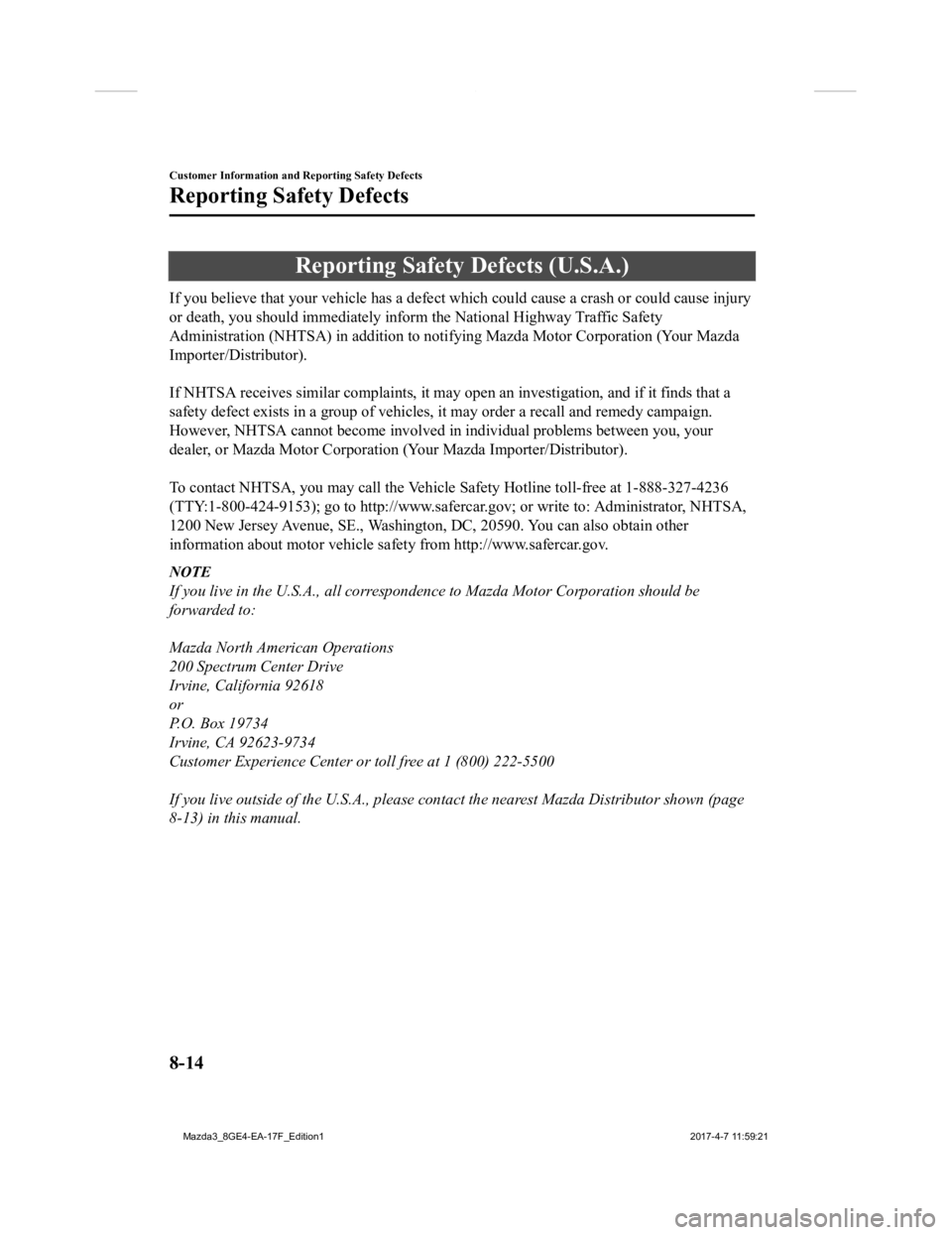
Reporting Safety Defects (U.S.A.)
If you believe that your vehicle has a defect which could cause a crash or could cause injury
or death, you should immediately inform the National Highway Tr affic Safety
Administration (NHTSA) in addition to notifying Mazda Motor Cor poration (Your Mazda
Importer/Distributor).
If NHTSA receives similar complaints, it may open an investigat ion, and if it finds that a
safety defect exists in a group of vehicles, it may order a rec all and remedy campaign.
However, NHTSA cannot become involved in individual problems be tween you, your
dealer, or Mazda Motor Corporation (Your Mazda Importer/Distrib utor).
To contact NHTSA, you may call the Vehicle Safety Hotline toll- free at 1-888-327-4236
(TTY:1-800-424-9153); go to http: //www.safercar.gov; or write to: Administrator, NHTSA,
1200 New Jersey Avenue, SE., Washington, DC, 20590. You can als o obtain other
information about motor vehicle s afety from http://www.safercar.gov.
NOTE
If you live in the U.S.A., all correspondence to Mazda Motor Corporation should be
forwarded to:
Mazda North American Operations
200 Spectrum Center Drive
Irvine, California 92618
or
P.O. Box 19734
Irvine, CA 92623-9734
Customer Experience Center or toll free at 1 (800) 222-5500
If you live outside of the U.S.A., please c ontact the nearest Mazda Distributor shown (page
8-13) in this manual.
Customer Information and Reporting Safety Defects
Reporting Safety Defects
8-14
Mazda3_8GE4-EA-17F_Edition1 2017-4-7 11:59:21
Page 565 of 624
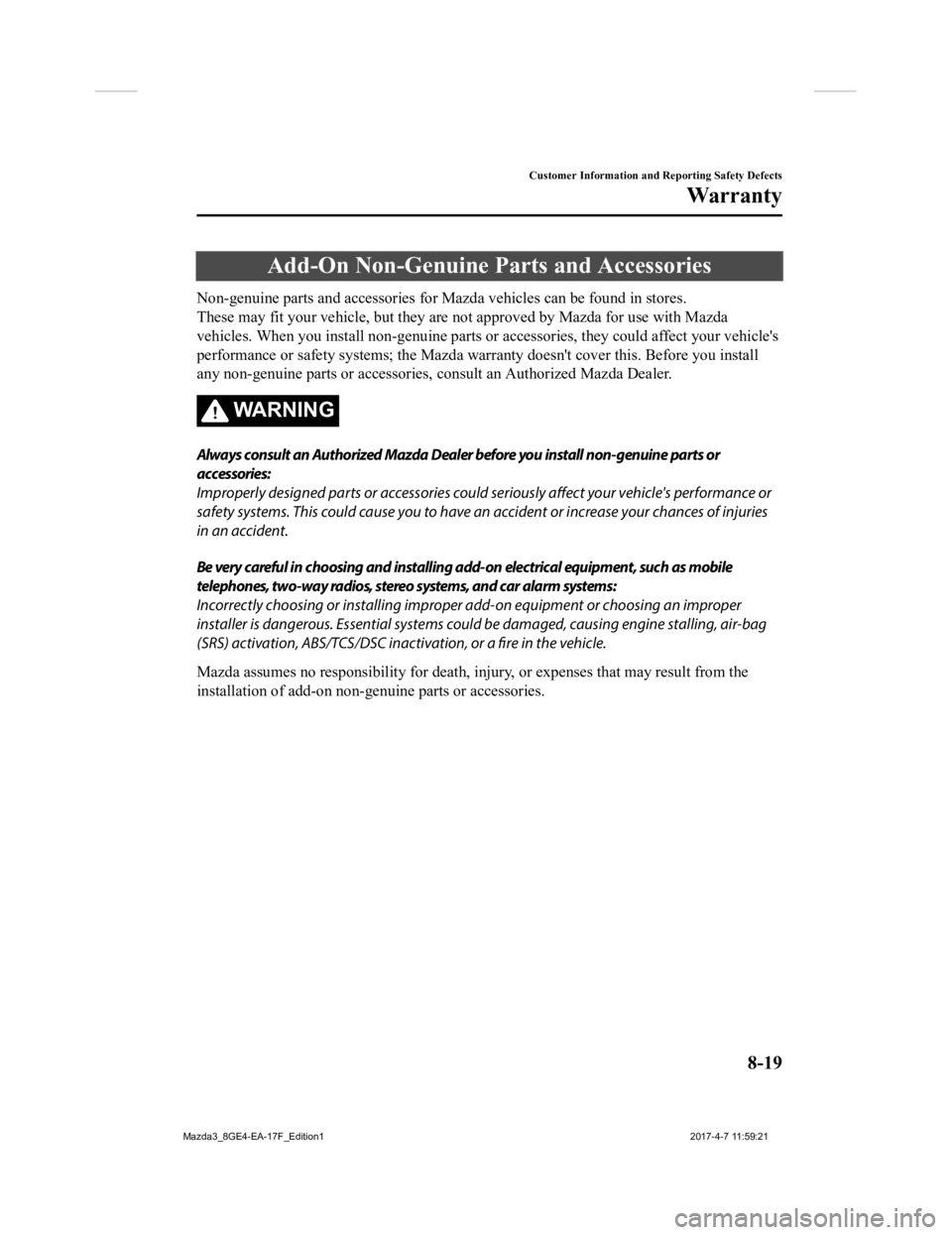
Add-On Non-Genuine Parts and Accessories
Non-genuine parts and accessories for Mazda vehicles can be found in stores.
These may fit your vehicle, but they are not approved by Mazda for use with Mazda
vehicles. When you install non-genuine parts or accessories, th ey could affect your vehicle's
performance or safety systems; th e Mazda warranty doesn't cover this. Before you install
any non-genuine parts or accessories, consult an Authorized Maz da Dealer.
WA R N I N G
Always consult an Authorized Mazda Dealer before you install non-genuine parts or
accessories:
Improperly designed parts or accessories could seriously affect your vehicle's performance or
safety systems. This could cause you to have an accident or increase your chances of injuries
in an accident.
Be very careful in choosing and installing add-on electrical equipment, such as mobile
telephones, two-way radios, stereo systems, and car alarm systems:
Incorrectly choosing or installing improper add-on equipment or choosing an improper
installer is dangerous. Essential systems could be damaged, causing engine stalling, air-bag
(SRS) activation, ABS/TCS/DSC inactivation, or a fire in the vehicle.
Mazda assumes no responsibility for death, injury, or expenses that may result from the
installation of add-on non-genuine parts or accessories.
Customer Information and Reporting Safety Defects
Wa r r an t y
8-19
Mazda3_8GE4-EA-17F_Edition1 2017-4-7 11:59:21
Page 566 of 624
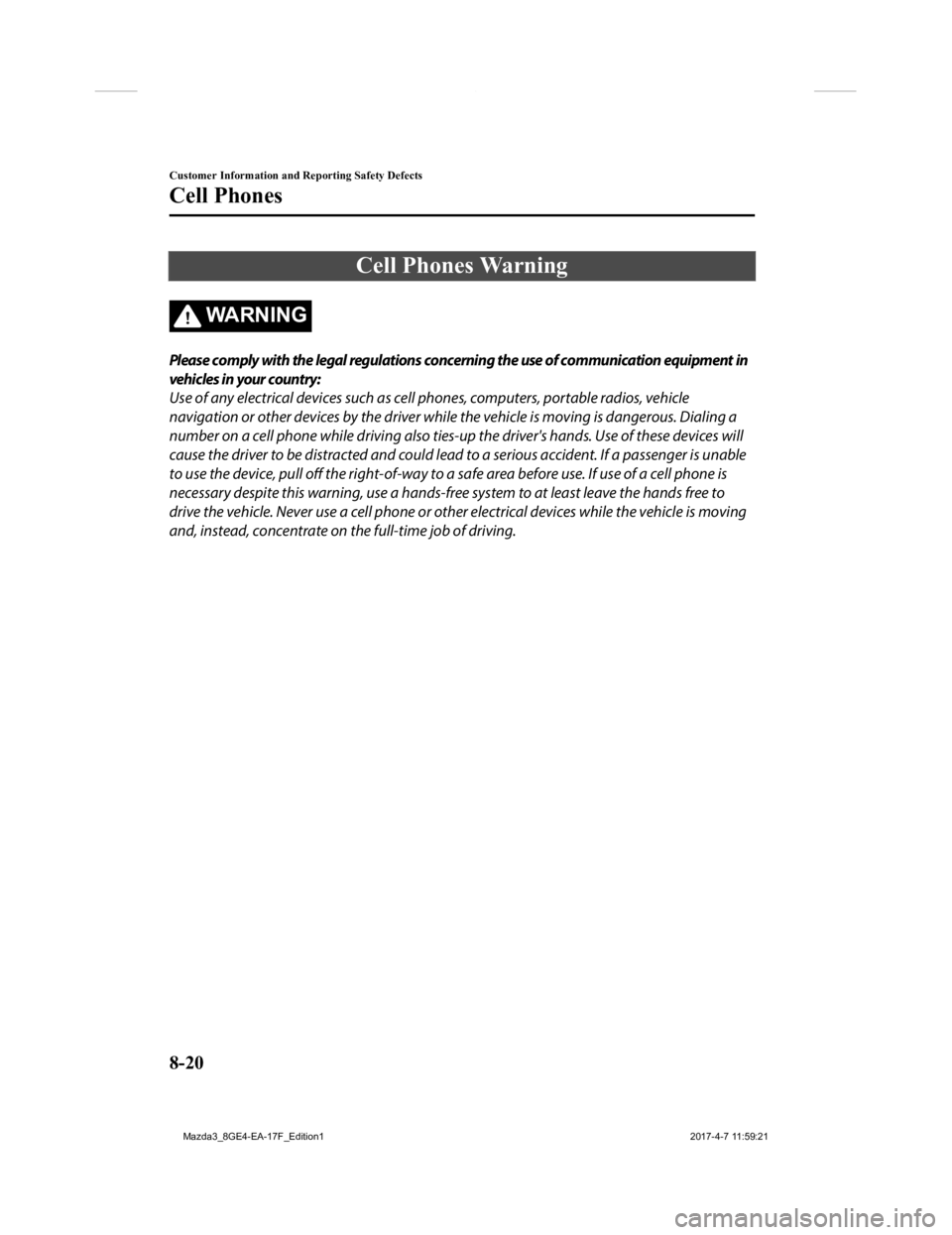
Cell Phones Warning
WA R N I N G
Please comply with the legal regulations concerning the use of communication equipment in
vehic les in your country:
Use of any electrical devices such as cell phones, computers, portable radios, vehicle
navigation or other devices by the driver while the vehicle is moving is dangerous. Dialing a
number on a cell phone while driving also ties-up the driver's hands. Use of these devices will
cause the driver to be distracted and could lead to a serious accident. If a passenger is unable
to use the device, pull off the right-of-way to a safe area before use. If use of a cell phone is
necessary despite this warning, use a hands-free system to at least leave the hands free to
drive the vehicle. Never use a cell phone or other electrical devices while the vehicle is moving
and, instead, concentrate on the full-time job of driving.
Customer Information and Reporting Safety Defects
Cell Phones
8-20
Mazda3_8GE4-EA-17F_Edition1 2017-4-7 11:59:21
Page 569 of 624
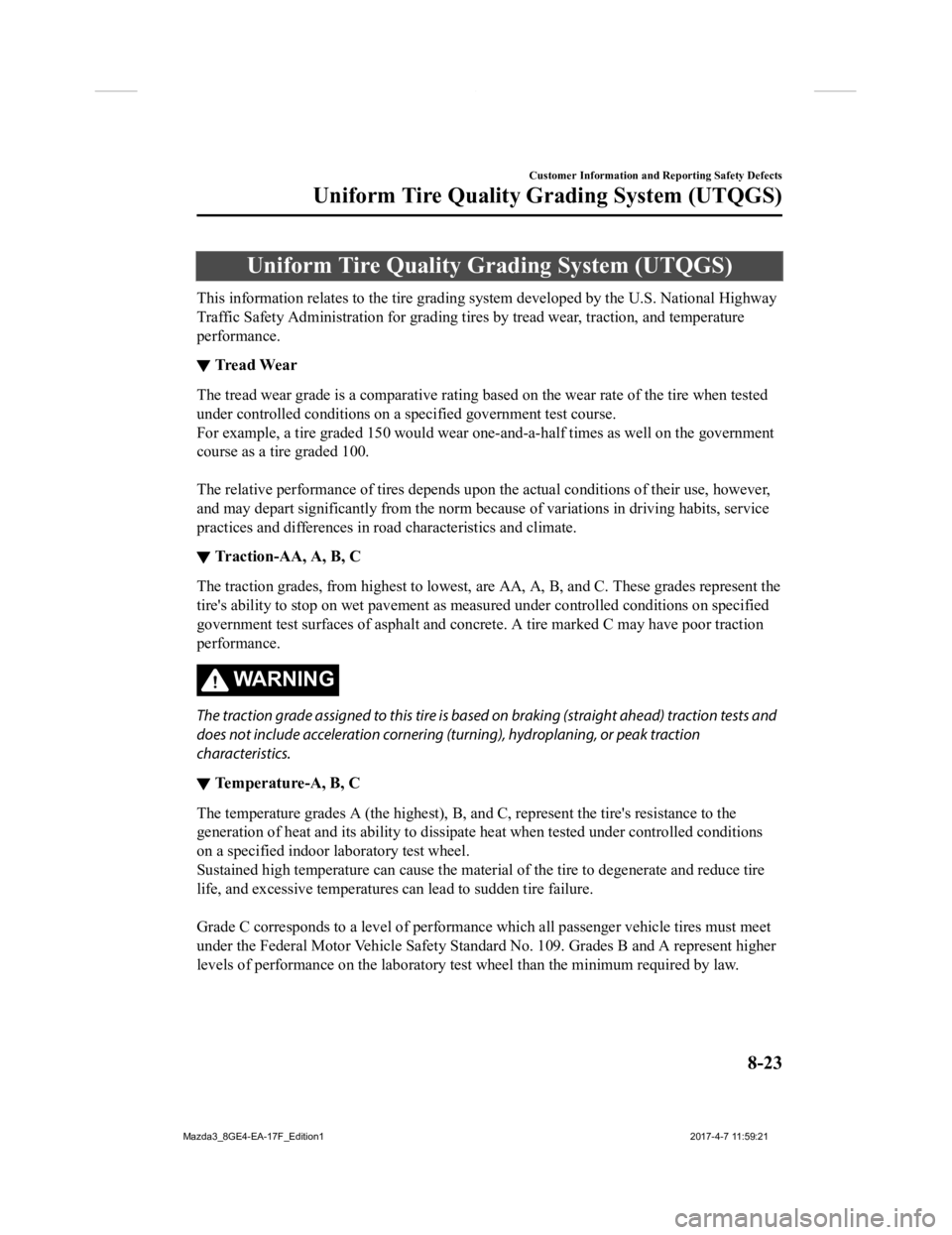
Uniform Tire Quality Grading System (UTQGS)
This information relates to the tire grading system developed by the U.S. National Highway
Traffic Safety Administration for grading tires by tread wear, traction, and temperature
performance.
▼ Tr e a d We a r
The tread wear grade is a comparative rating based on the wear rate of the tire when tested
under controlled conditions on a specified government test cour
se.
For example, a tire graded 150 would wear one-and-a-half times as well on the government
course as a tire graded 100.
The relative performance of tires depends upon the actual condi tions of their use, however,
and may depart significantly from the norm because of variation s in driving habits, service
practices and differences in ro ad characteristics and climate.
▼Traction-AA, A, B, C
The traction grades, from highest
to lowest, are AA, A, B, and C. These grades represent the
tire's ability to stop on wet pavement as measured under contro lled conditions on specified
government test surfaces of asphalt and concrete. A tire marked C may have poor traction
performance.
WA R N I N G
The traction grade assigned to this tire is based on braking (straight ahead) traction tests and
does not include acceleration cornering (t urning), hydroplaning, or peak traction
characteristics.
▼ Temperature-A, B, C
The temperature grades A (the hi
ghest), B, and C, represent the tire's resistance to the
generation of heat and its ability to dissipate heat when teste d under controlled conditions
on a specified indoor laboratory test wheel.
Sustained high temperature can cause the material of the tire to degenerate and reduce tire
life, and excessive temperatures can lead to sudden tire failure.
Grade C corresponds to a level of performance which all passeng er vehicle tires must meet
under the Federal Motor Vehicle Safety Standard No. 109. Grades B and A represent higher
levels of performance on the labo ratory test wheel than the minimum required by law.
Customer Information and Reporting Safety Defects
Uniform Tire Quality G rading System (UTQGS)
8-23
Mazda3_8GE4-EA-17F_Edition1 2017-4-7 11:59:21
Page 570 of 624

WA R N I N G
Keep your vehicle's tires properly inflated and not overloaded:
Driving with improperly inflated or overload ed tires is dangerous. Excessive speed,
underinflation, or excessive loading, either separately or in combination, can cause heat
buildup and possible tire failure. The temperature grade for this tire is established for a tire
that is properly inflated and not overloaded.
These grades will be added to the sidewalls of passenger vehicl e tires over the next several
years according to a schedule established by the NHTSA and the tire manufacturers.
The grade of tires available as standard or optional equipment on Mazda vehicles may vary
with respect to grade.
ALL PASSENGER VEHICLE TIRES MUST CONFORM TO THESE GRADES AND TO
ALL OTHER FEDERAL TIRE-SAFETY REQUIREMENTS.
▼ UNIFORM TIRE QUALITY GRADING
Quality grades can be found where applicable on the tire sidewa
ll between tread shoulder
and maximum section width.
For example:
TREADWEAR 200 TRACTION AA TEMPERATURE A
UTQGS MARK (example)
Customer Information and Reporting Safety Defects
Uniform Tire Quality G rading System (UTQGS)
8-24
Mazda3_8GE4-EA-17F_Edition1 2017-4-7 11:59:21
Page 582 of 624
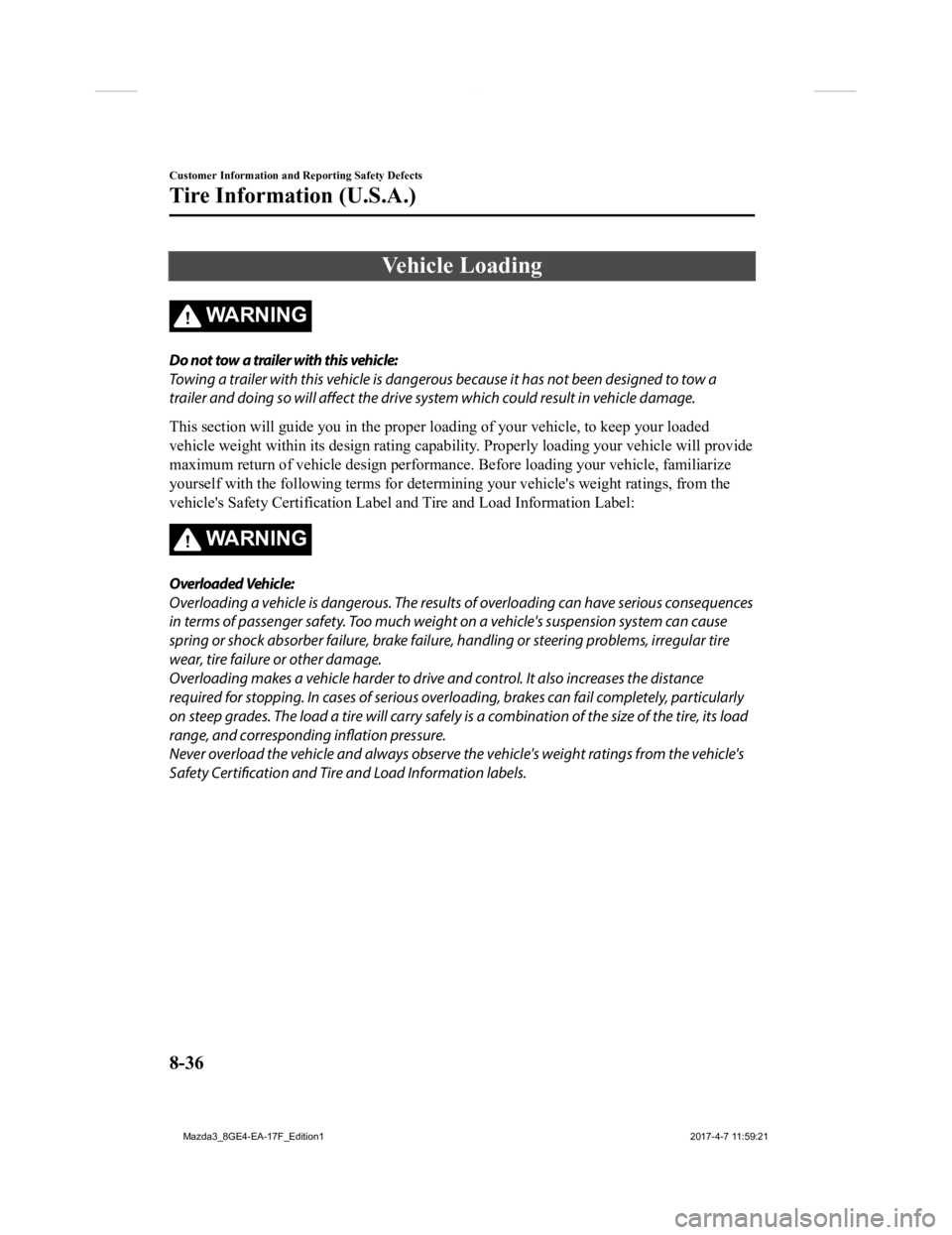
Ve h i c l e L o a d i n g
WA R N I N G
Do not tow a trailer with this vehicle:
Towing a trailer with this vehicle is dangerous because it has not been designed to tow a
trailer and doing so will affect the drive system which could result in vehicle damage.
This section will guide you in the proper loading of your vehicle, to keep your loaded
vehicle weight within its desi gn rating capability. Properly lo ading your vehicle will provide
maximum return of vehicle design performance. Before loading yo ur vehicle, familiarize
yourself with the following terms for determining your vehicle' s weight ratings, from the
vehicle's Safety Certification La bel and Tire and Load Information Label:
WA R N I N G
Overloaded Vehicle:
Overloading a vehicle is danger ous. The results of overloading can have serious consequences
in terms of passenger safety. Too much weight on a vehicle's suspension system can cause
spring or shock absorber failure, brake failure, handling or steering problems, irregular tire
wear, tire failure or other damage.
Overloading makes a vehicle harder to drive and control. It also increases the distance
required for stopping. In cases of serious overloading, brakes can fail completely, particularly
on steep grades. The load a tire will carry safely is a combination of the size of the tire, its load
range, and corresponding inflation pressure.
Never overload the vehicle and always observe th e vehicle's weight ratings from the vehicle's
Safety Certification and Tire and Load Information labels.
Customer Information and Reporting Safety Defects
Tire Information (U.S.A.)
8-36
Mazda3_8GE4-EA-17F_Edition1 2017-4-7 11:59:21
Page 590 of 624
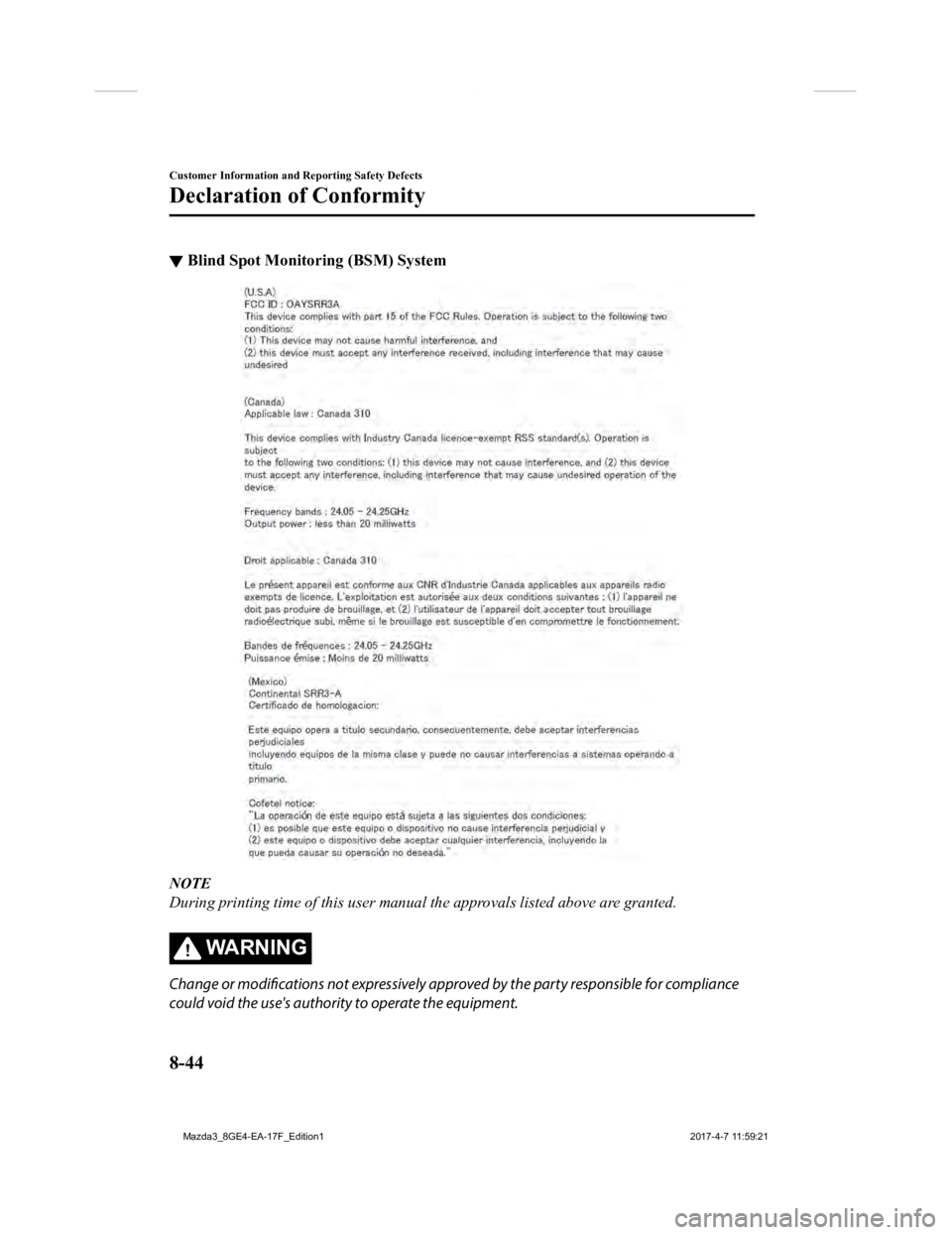
▼Blind Spot Monitoring (BSM) System
NOTE
During printing time of this user manual the approvals listed above are granted.
WA R N I N G
Change or modifications not ex
pressively approved by the party responsible for compliance
could void the use's authority to operate the equipment.
Customer Information and Reporting Safety Defects
Declaration of Conformity
8-44
Mazda3_8GE4-EA-17F_Edition1 2017-4-7 11:59:21
Page 591 of 624
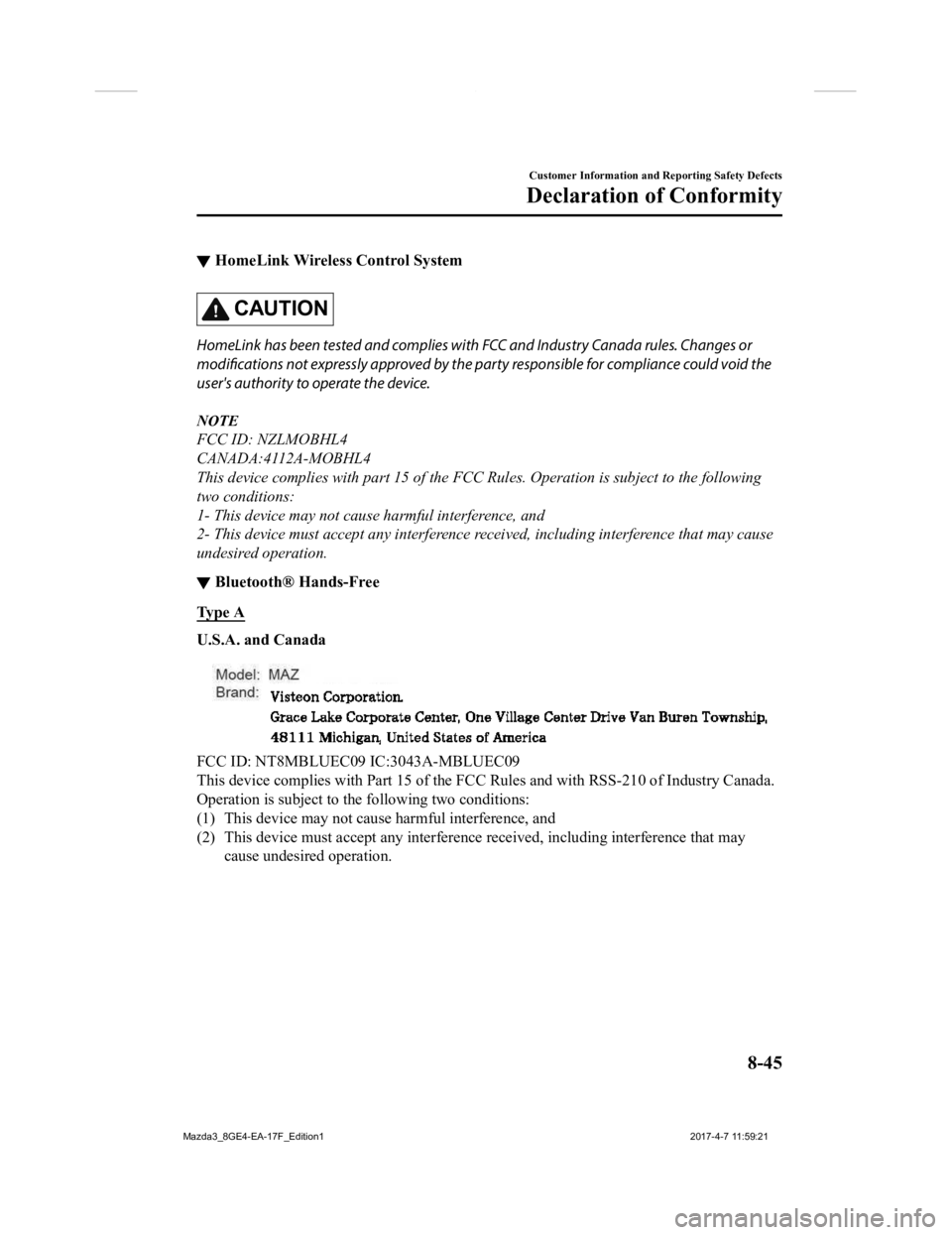
▼HomeLink Wireless Control System
CAUTION
HomeLink has been tested and
complies with FCC and Industry Canada rules. Changes or
modifications not expressly approved by the party responsible for compliance could void the
user's authority to operate the device.
NOTE
FCC ID: NZLMOBHL4
CANADA:4112A-MOBHL4
This device complies with part 15 of the FCC Rules. Operation is subject to the following
two conditions:
1- This device may not cause harmful interference, and
2- This device must accept any interference received, including interference that may cause
undesired operation.
▼ Bluetooth® Hands-Free
Ty p e A
U.S.A. and Canada
FCC ID: NT8MBLUEC09 IC:3043A-MBLUEC09
This device complies wi
th Part 15 of the FCC Rules and with RSS -210 of Industry Canada.
Operation is subject to the following two conditions:
(1) This device may not cause harmful interference, and
(2) This device must accept any interference received, including interference that may cause undesired operation.
Customer Information and Reporting Safety Defects
Declaration of Conformity
8-45
Mazda3_8GE4-EA-17F_Edition1 2017-4-7 11:59:21